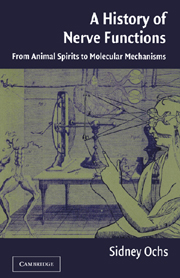Book contents
- Frontmatter
- Contents
- Preface
- 1 Introduction: Greek Science and the Recognition of Nerve as a Channel
- 2 Galen's Physiology of the Nervous System
- 3 Nerve, Brain, and Soul in the Middle Ages
- 4 Renaissance and the New Physiology
- 5 New Physical and Chemical Models of Nerve in the Enlightenment
- 6 New Systematizations of Nerve Function in the Enlightenment
- 7 Electricity as the Agent of Nerve Action
- 8 Nerve Fiber Form and Transformation
- 9 Wallerian Degeneration: Early and Late Phases
- 10 Nerve Regeneration
- 11 Characterization of Axoplasmic Transport
- 12 Molecular Models of Transport
- 13 Actions of Neurotoxins and Neuropathic Changes Related to Transport
- 14 Purposeful Reflexes and Instinctive Behavior
- 15 Neural Events Related to Learning and Memory
- 16 Epilogue: With Observations on the Relation of the Nervous System to Mind
- Bibliography
- Index
4 - Renaissance and the New Physiology
Published online by Cambridge University Press: 13 August 2009
- Frontmatter
- Contents
- Preface
- 1 Introduction: Greek Science and the Recognition of Nerve as a Channel
- 2 Galen's Physiology of the Nervous System
- 3 Nerve, Brain, and Soul in the Middle Ages
- 4 Renaissance and the New Physiology
- 5 New Physical and Chemical Models of Nerve in the Enlightenment
- 6 New Systematizations of Nerve Function in the Enlightenment
- 7 Electricity as the Agent of Nerve Action
- 8 Nerve Fiber Form and Transformation
- 9 Wallerian Degeneration: Early and Late Phases
- 10 Nerve Regeneration
- 11 Characterization of Axoplasmic Transport
- 12 Molecular Models of Transport
- 13 Actions of Neurotoxins and Neuropathic Changes Related to Transport
- 14 Purposeful Reflexes and Instinctive Behavior
- 15 Neural Events Related to Learning and Memory
- 16 Epilogue: With Observations on the Relation of the Nervous System to Mind
- Bibliography
- Index
Summary
The recovery of long-lost Greek literature and science manuscripts and their translation into Latin led not only to an admiration of the achievements of past masters, but also before long a desire to emulate and surpass them. Starting first in Florence, where the “Florentine Renaissance” began in the mid-fourteenth century with the enthusiasm of Petrarch in his search for ancient manuscripts, the restoration of learning spread elsewhere in Italy and then to all of Europe in the fifteenth and sixteenth centuries. The Renaissance gave rise to the remarkable literary and artistic achievements of such men as Botticelli, Donatello, Michelangelo, Leonardo da Vinci, Erasmus, among others. The enthusiasm for learning and the expression of individualism characterized those of the Renaissance, differentiating them from the conformity to church doctrine of the preceding centuries that came to be called the “Middle Ages” or the “Dark Ages.”
A contrast developed between the universities, with their need to provide training for clerics and where church matters took precedence, and the new humanistic circles in which laymen and clerics mingled freely under the protection of princes, popes, and such powerful families as the Medici, who gave support to the arts and sciences. Through them, “the modern age began with the acceptance of the autonomy of intellectual methods and problems” to fulfill the desire of knowledge for its own sake, as well as for worldly gain. New findings were investigated, and new things brought to light.
Information
- Type
- Chapter
- Information
- A History of Nerve FunctionsFrom Animal Spirits to Molecular Mechanisms, pp. 50 - 62Publisher: Cambridge University PressPrint publication year: 2004
Accessibility standard: Unknown
Why this information is here
This section outlines the accessibility features of this content - including support for screen readers, full keyboard navigation and high-contrast display options. This may not be relevant for you.Accessibility Information
- 1
- Cited by
